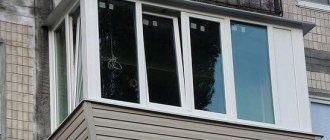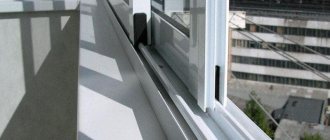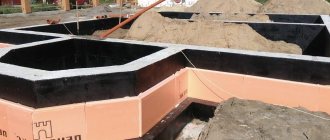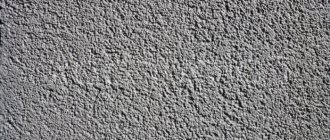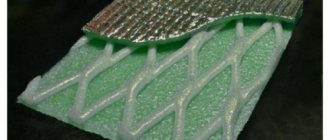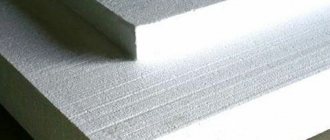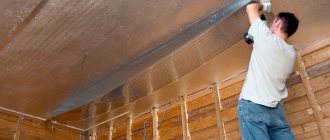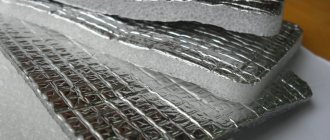Polyethylene is an unpretentious and inexpensive material, therefore it is actively used in everyday life and in some cases is irreplaceable. Sometimes situations arise in which it is necessary to glue the material, for example, when constructing a greenhouse. Not all compositions are effective in this case; you will need to use a special glue for polyethylene, which has excellent adhesive properties.
Classic (non-crosslinked) polyethylene foam backing
Polyethylene foam underlay material for floor coverings is made from polyethylene foam. Structurally, it consists of small-format gas-filled chambers ranging in size from 1 to 3 mm.
If previously unsafe freon was used as a gas, today it has been successfully replaced by isobutane, propane-butane and butane mixtures.
Typically found in white, yellow, grey, light green or blue. Color characteristics in this case do not have technical significance.
It wouldn’t hurt to find out how thick the polyethylene backing is: it comes in a wide variety – these include samples with a minimum thickness of 0.8; 1 mm, and the most commonly used substrate, the thickness of which is 2, 3 and 4 mm, as well as thicker samples with a thickness of 5 and 6 mm.
The standard roll width is 1 or 1.5 m, and the length is 25 or 50 m. You can also find sheet polyethylene foam with parameters of 1x2 m.
Specifications
- density – 25 (±5) kg/m3;
- thermal conductivity coefficient – 0.045-0.055 W/(m∙°C);
- specific heat capacity – 1.95 kJ/(kg°C);
- vapor permeability – 0.03 mg/(m.h.Pa);
- water absorption throughout the entire volume with complete immersion of the material 96 h ˂1%;
- compressive stress – 0.015 MPa;
- relative residual strain in compression ≤ 20%;
- operating temperature - -60/+75°С.
The classic polyethylene foam substrate, described above, has several advantages. The most significant of them is excellent moisture resistance, which indicates the possibility of its flooring in any room, including excessively humid ones.
However, such polyethylene foam substrates, the price of which is recognized as the lowest of the entire range, are short-lived due to the high susceptibility of the substrate to wear. Under the constant influence of large objects, it is greatly deformed, in other words, it is pressed through.
Under prolonged static loads, it practically does not restore its previous thickness, that is, it loses elasticity, which leads to its rapid thinning and, in the worst case, turning into powder.
The same thing awaits the underlay material when the floor covering is constantly exposed to ultraviolet rays. The combination of exposure to UV rays and oxygen is especially harmful.
The polyethylene foam backing for laminate, linoleum, parquet boards or any other covering lasts much less than the floor material itself.
Thus, after a certain service life, the lining needs to be replaced, which cannot always be done quickly when it comes to laminate or parquet floors.
Additional tips and tricks
When working with edge glue, you should follow a number of recommendations:
- the surface on which the composition will be applied must be cleaned of dust and degreased;
- in the room where work is carried out, ensure a temperature of +18 ⁰С and above;
- eliminate the presence of drafts, especially in winter, since a decrease in temperature can lead to the hardening of the edge glue ahead of schedule;
- maintain normal humidity in the room;
- if necessary, remove the old edge tape by heating it with a hairdryer or iron and carefully removing it;
- glue consumption is more economical if a brand with a lower density is used;
- PUR-based adhesive is more economical than EVA-based adhesive.
It must be remembered that when using a manual machine for gluing edges, productivity increases significantly, but all its parameters must be accurately set:
- continuous operation time;
- edge thickness;
- maximum and minimum of its height;
- feed speed;
- maximum workpiece dimensions;
- weight of the hand machine.
The operation of the device may be affected by:
- availability of different types of attachments for edges;
- the inclusion of a special dispenser for edge glue;
- the ability to rotate the part;
- ease of operation and maintenance of the device.
Share link:
How to glue correctly: advice from professionals
Before starting work, you need to prepare tools and materials: the foam boards themselves, a primer for coating the concrete surface, a brush or roller, a degreaser, a spray bottle. It is also advisable to take care of personal protective equipment.
Glue application methods:
- Stripes - four L-shaped stripes are applied to the sheet in the corners and two long ones in the center, giving an average level of fixation.
- Point - dense drops are applied in increments of 30 centimeters, fixation is of the least quality.
- Continuous - the adhesive composition is evenly applied over the entire area of the sheet, retreating 3-4 centimeters from the edge, this way it is possible to achieve the highest quality connection.
What you need to remember when gluing penofol to concrete:
- It is advisable to do the work together.
- You need to study the instructions in advance, calculate the glue consumption, and purchase the optimal volume.
- For beginners, aerosol glue is best.
- Concrete must first be treated with a primer, which will protect against fungus and increase adhesion.
- If possible and funds allow, it is better to apply the glue in a continuous layer with a maximum thickness of 2-3 millimeters.
- The sheets are leveled immediately after they come into contact with the work surface.

Specifications
The main properties and characteristics of foamed polyethylene are as follows:
- The density of PPE depends on the method of its production and is: for FPPE and HPPE - from 33 kg/m3 to 300-500 kg/m3. Non-crosslinked PPE is much lighter. According to the specifications, its density must be at least 20 kg/m3, but in fact, material with a density of 12-18 kg/m3 is sold.
- The temperature of use (from different manufacturers) varies within ± 10 C, but on average, the limits of its operating temperatures range from - 60 C ... + 75 C. In the absence of contact with air, FPPE and HPPE can be used for a short time at temperatures up to +150 C (uncrosslinked up to +100 C). If you use PPE at temperatures below - 60 C, the material becomes brittle, and its residual deformation increases to 35-40%.
- Foamed polyethylene, like all polymers with a closed-porous structure, has a low thermal conductivity coefficient of 0.03-0.38 W/m*K. Foamed polyethylene insulation is second only to polyurethane foam in its heat-saving characteristics.
- Cross-linked and non-cross-linked PPE have different vapor permeability. For non-crosslinked - this figure is within 0.003 mg/m*h*Pa, for cross-linked it is almost three times less - 0.001 mg/m*h*Pa.
Table: Properties of adhesives for polyethylene
| Name | Thermaflex TermaEco | Armaflex 520 glue | Contact glue K-Flex K 467 |
| Brand | Thermaflex | Armaflex | K-Flex |
| Material | neoprene based | on a polychloroprene basis, without aromatic solvents | on polychloroprene rubber |
| Application temperature | from -40 to +105 ºС | from -50ºС to +105 ºС | from -40 to +105 ºС |
| Consumption | for pipe insulation with a thickness of 6 mm – 1 liter per 150 linear meters. m; 9 mm – 1 l per 120 linear. m; 13 mm – 1 l per 100 linear. m; 20 mm – 1 l per 70 linear. m; 25 mm – 1 l per 50 linear. m; for flat surfaces and rectangular air ducts – 1 liter per 10 linear meters. m; for pipes with a diameter of more than 114 mm - 1 liter per 6 linear meters. m | Minimum adhesive consumption, applied to both surfaces: Armaflex tubes (thickness > consumption for gluing tube seams without a cut > consumption for gluing tube seams with a cut): 10 mm > 1120 m/l > 140 m/l 20 mm > 280 m/l > 70 m/l30 mm > 175 m/l > 45 m/l40 mm > 130 m/l > 35 m/l | for pipe insulation with a thickness of 9 mm – 1350 linear meters; 13 mm – 500 linear m; 19 mm – 300 linear m; 25 mm – 220 linear m; for flat surfaces and 6–8 sq.m.; |
| Package | jar 0.5 l; 1 l and 3 l | can 0.25 l; 0.5 l; 1 l and 2.5 l | 2.6 l can |
Analogs
There are many analogues of E8000 glue:
- B7000. This is one of the most popular compounds used as a sealant for touch screens. In this case, the product is considered multi-purpose. It can be used for fixing glass elements, plastic, wood, and metal. Key characteristics include high joint strength. The finished seam can be more reliable than fixed parts.
- T7000. This tool is also used to fix touch screens and cellular communication modules. A distinctive feature is the black color. Therefore, glue can be used to repair dark cases. The product is resistant to moisture and mechanical factors.
- T8000. This composition is actively used for domestic purposes. However, the main purpose is considered to be fixing touchscreens. According to the principle of action, the composition resembles double-sided tape, but provides a more durable connection. For repeated repairs, the substance is easily removed by heating and rolling. It takes 3-5 minutes for the composition to dry. The duration of final drying is 1-2 days.
- B8000. The composition is also intended for sealing and fixing touchscreens. The product is intended for repairing iPhone parts, since it definitely does not corrode surfaces. If you need to remove the glue, heat it with a hair dryer. The product has a completely transparent consistency. Polymerization takes 2-3 days.
E8000 glue is highly effective and helps to fix parts of mobile devices and other gadgets. To achieve success in using a substance, you must use it correctly. To do this, it is recommended to thoroughly clean and dry the surface, then apply a thin layer of glue.
Share link:
Review of popular solutions
To fix foam plastic, universal means, one-component substances, mineral mixtures, and polymer glues are used, the list of which is constantly growing.
Weicon Easy-Mix-PE-PP 45
The product, which contains methyl methacrylate, is produced in the form of a yellowish paste that becomes transparent after hardening. The two-component adhesive has high adhesion, can withstand -50, hardens completely in 6 hours, and is used for joining:
- fiberglass;
- polycarbonate:
- polyvinyl chloride.
Before applying the composition, the surface does not require preliminary preparation. The peel strength of the adhesive is 2.9 N/mm.

"Titanium"
Titan Wild has been used in construction and renovation work to connect different surfaces since the 90s. Cyanoacrylate glue is applied in a layer less than 4 mm thick; the composition is effective even at very high temperatures. The hardened seam does not delaminate under heavy load. The consistency of the product resembles polyurethane foam, but does not shrink. The glue dries in 60 minutes and is applied in 2 layers. After drying, the seam is not destroyed by ultraviolet rays and does not absorb moisture.
Atlas Stopter K-20
The mineral mixture is used for gluing insulating polystyrene foam boards when insulating buildings, as well as for creating a reinforcing layer. Microscopic fibers present in the glue give it resistance to cracking, high adhesion, and elasticity. The building mixture connects the panels to plastered walls, brick, and aerated concrete.
"T-vanguard"
The adhesive, consisting of a polymer and filler, is available in the form of a dry mixture, suitable for attaching polystyrene boards to the facade of a building and indoors. "T-avant-garde" is packaged in paper bags of 25 kg, applied:
- on concrete;
- brick;
- plaster.
The surface to which the panels are attached is degreased and leveled in advance. The mixture is combined with cold water and consumed in half an hour.
"Akrol"
The adhesive, which contains additives that increase adhesion, ensures a strong connection of the insulating board to glass, metals, and concrete, even at high temperatures and humidity. Akrol glue seals small cracks, masks unevenness, is applied to a dry surface in a continuous layer, and pressed against the base. The glue does not need to be diluted, since it is packaged into parts and ready for use.
See also
The best ways to make your own glue at home

"Neoprene-2136"
In order for foamed polyethylene to perform the functions of insulation and insulating material, it can be secured to a wall that has been cleaned and treated with an antiseptic solution using Neoprene-2136 spray. The adhesive is made on the basis of rubber, contains additives and fillers in the form of silicon dioxide and calcium silicate, and provides adhesion in a quarter of an hour. The compound is resistant to the action of acetone, alcohol, and aliphatic hydrocarbons.
"Ceresit"
Construction adhesive with high adhesion allows you to attach polystyrene boards and ceramics even to surfaces subject to shrinkage.
The product, produced by Henkel, fills the seams and reliably adheres the insulating material to the surface.
Several types of Ceresit glue are used for connecting slabs inside and outside a building, which is valued for its characteristics, which differ in:
- resistance to sub-zero temperatures;
- water-repellent property;
- high adhesion;
- ease of care.
The Ceresit line contains cement, which upon contact with liquid enters into an alkaline reaction. When working with glue, you need to protect your skin so as not to cause irritation.
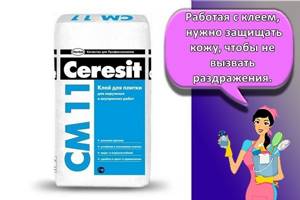
"Olfix"
The product produced by Knayf is suitable for gluing mineral wool and expanded polystyrene panels to plaster and brick walls with an uneven surface. The glue, made from gypsum and additives, is poured with cold water and applied in portions in the center and along the sheet. The glued board is pressed against the base and aligned in one plane.
Penoplex Fastfix
To fix extruded polystyrene foam panels, foam adhesive based on plastic polyurethane is used. Penoplex dries in 10 minutes, hardens in a day, is suitable for external work, internal thermal insulation, and provides adhesion to plaster, expanded clay concrete, building stone, and wood.
Insta-stick
The polyurethane-based product firmly secures foam foam boards to horizontal and vertical surfaces of brick, metal, and concrete. Insta-stick glue is economical in consumption, is not afraid of frost, and does not contain harmful substances. During commit:
- Doesn't splash.
- Does not leave any dirt.
- Doesn't gather dust.
The supply of the composition is regulated by pressing the valve. The glue is applied in strips, and after foaming it hardens in an hour or two.
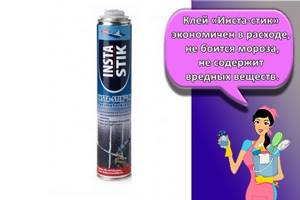
"Moment"
In everyday life, construction and repair, a Russian-German product has been used for many years, which is constantly being improved and replenished with new varieties. Moment glue firmly and quickly secures ceiling skirting boards, foam tiles, parquet, and polypropylene products. The two-component composition reliably fixes materials that are exposed to steam, water, and vibration.
See also
2 recipes for making starch paste at home
BF-2
The viscous alcohol solution, which contains phenol-formaldehyde resins and vinyl acetate polymer, developed in the Soviet Union after the war, does not corrode, does not rot, and does not deform when heated. BF-2 glues metal, plastic, polystyrene foam, ceramics using the cold and hot method. The thickened composition is diluted with alcohol. When fixing in room conditions, the product is applied in 2 thin layers, in a drying cabinet - in one.
BF-4
Butyral-phenolic glue connects metal surfaces, textile fabrics, leather, glass, wood. The durable seam is not dissolved by gasoline and is not afraid of moisture. BF-4 ideally fastens products subject to bending and impact. With the hot method, the parts are glued together in 40 minutes. With the cold method, the composition is applied in 2 layers with an interval of half an hour.
Composition and properties
There are two types of glue sticks. They are made on the basis of PVA and PVP. These foundations are moisturizers. The performance properties and application of the compositions differ from each other.
Based on PVA
The base of the PVA glue stick is polyvinyl acetate. The active ingredient is glycerol. This is a synthetic component that is a viscous transparent liquid. Glycerol has viscosity. It doesn't smell. The moisturizing properties of glycerol are lower than those of glycerol. Various components are added to PVA glue to improve its qualities:
- tricresyl phosphate,
- EDOS,
- acetone,
- esters.
These substances improve glue adhesion. PVA glue dries faster. The shelf life of PVA pencil glue is 1.5-2 years. After this, the rod dries, turning into a dense plastic cylinder. At the same time, it is separated from the tube. But it also has less fixation time on the surface. It only takes 2 minutes for the PVA pencil adhesive to dry completely.
PVA glue stick can be exposed to high temperatures. But its lower threshold is limited to 15 degrees Celsius. At lower temperatures, the glue hardens quickly. It becomes difficult or completely impossible to smear it. PVA glue does not dissolve in water. He is not afraid of oil attacks. Atmospheric phenomena do not affect it in any way. The only thing he doesn't like is temperature changes.
Conclusion. PVA-based glue sticks have a wider range of applications.
PVP
The base of the PVP glue stick is glycerin. This is a natural substance that effectively protects the glue from drying out. Glycerin absorbs moisture from the environment. He is able to hold it for a long time.
The drying speed of the finished work increases to 5 minutes. Unlike PVA, a PVP pencil connects not only parts of cardboard and paper. It glues photo paper and fabric together. The glue is more resistant to low temperatures than PVA. He is less afraid of her swings. The paper does not deform after gluing PVP. The glue does not change the color of the materials being glued.
The composition of PVP glue is more complex. It varies depending on the manufacturer. We can only talk about a small list of components that may be included in it in addition to glycerin:
- Water. It serves as a natural solvent. Evaporating allows the composition to harden.
- Acrylic polymer is the main adhesive component, thanks to which the substance dries and polymerizes.
- Sodium stearate is a substance that makes the adhesive mass more plastic and facilitates friction.
- Polyethylene glycol - this substance is added to the adhesive to maintain flexibility.
- Polyoxyethylene monooctylphenyl ether is a chemical compound that acts as an emulsifier, ensuring the creation of an emulsion when mixing dissimilar components.
- N-vinylpyrrolidone polymer is an ingredient that enhances polymerization.
- Aminomethylpropanol is a buffer that neutralizes acids and promotes safe adhesive application.
- Sodium hydroxide is an alkali. It is added to maintain the neutral pH balance of the adhesive.
The glue stick may contain hydrogen peroxide and caprolactam, which gives the mass plasticity. If the glue stretches, forming threads, then this is the action of caprolactam.
How to choose glue for work
When buying a means for fixing popular insulation, you need to consider what finish it will be used for and what properties it should have.
Adhesion resistance
Under the influence of intermolecular forces, solid dissimilar particles begin to stick together. The composition of the product for installing foamed polyethylene must have high adhesion.
Thermal range
The glue used to fix penofol is stored in a dry room at 10–25 degrees. If the temperature drops to 5 during transportation, the product is heated to at least 20 before use.
See also
Choosing silicone glue for an aquarium, and which sealant is best to use
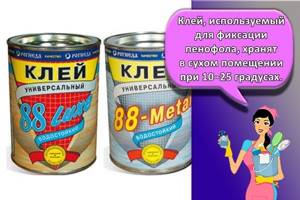
Toxicity
When installing insulation, there is no need to protect your eyes, skin, or respiratory organs, but you need to work with glue in a ventilated room, and pour the flammable substance away from fire sources.
Resistance to temperature changes and weather conditions
The adhesive used to attach insulation to the internal surface of a building or to external walls must withstand low temperatures, adhere to penofol in the heat, and not collapse after rain.
For saunas, baths water-repellent properties
Foamed polyethylene not only insulates living rooms, bedrooms of apartments, offices and warehouses, the material is used for vapor barrier of baths and saunas.
The glue used for these purposes must contain substances that repel moisture.
Leveling the floor before installation
For laminate flooring, leveling the floor is urgently necessary; without this stage of work, the consequences can be dire. Inexperienced craftsmen may not pay due attention to alignment, as a result of which they will receive the following:
- when laid on a curved surface, the load on individual elements will be higher, and the floor will deteriorate faster;
- the locking joints quickly become loose, and in just a couple of months they can begin to be damaged;
- Uneven gaps appear between the boards, which gives the floor an unaesthetic appearance.
The base must be as level as possible, and the materials used for this purpose must have high strength. Most often, leveling is carried out using tile adhesive, OSB and plywood, resulting in a so-called “dry screed”. Here are the features of the work:
- Plywood. Laying this material is advisable if the height differences are noticeable, but there is no high humidity in the room. Large deforming elements are removed and the floor is covered with an antiseptic composition. They cover the wooden sheathing with plywood, mount it on the floor, and secure it with self-tapping screws.
- Glue. You can also attach laminate to tile adhesive, making a kind of screed out of it. But this option is only suitable if there are small surface defects. The height differences in this case are no more than 3 mm. The glue is combined with sawdust or small shavings to prepare putty. The floor is poured with this mixture, leveled, and small cracks are sealed along the way.
- OSB. With this wear-resistant material you can easily make a dry screed, the price will be low. Installation is similar to that for plywood sheets.
Bonding foam to foam:
It is important how to glue the foam to the foam . To do this you can use:
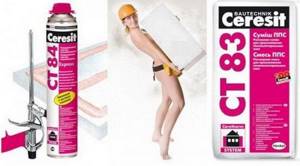
liquid foam;- concrete contact anhydrous mixtures;
- liquid nails;
- silicone sealants;
- special glue-foam;
- compositions for tiles.
Liquid foam is an adhesive substance that is created when there is no glue in the house. Can be used in case of sudden crack formation in the roofing material. The product must be dissolved and thereby obtain glue .
What material can replace the damper tape?
At the same time, we will immediately consider this problem.
Many people, when starting renovation work, try to save on literally everything. Naturally, such owners do not tend to buy compensation tape, but replace it with some materials that seem suitable to them. For example:
- Wooden slats are secured around the perimeter of the screed.
- Install pieces of polystyrene foam 10÷15 mm thick.
- Glue to the wall strips cut from the fabric of one of the roll insulation materials made from the same polyethylene foam.
The author considers it his responsibility to warn that all of these listed materials do not have the necessary characteristics, and, quite possibly, will not be able to perform all the functions expected of them.
Let's explain why:
Rolled insulation material, despite all the similarity of the material, does not fully have noise-absorbing abilities. In addition, its density is different from that provided for the damper tape, so over time it may begin to deform.
Using chopped insulating foil material as a compensation tape - you can soon experience disappointment from your “frugality”
- Wooden slats, even if they are wrapped in polyethylene, still will not acquire all the necessary characteristics. They will not be able to protect the screed from moisture, close the cold bridges along its edges and will not save you from vibration effects. Over time, under the influence of moisture, the wood will become unusable, which can negatively affect the concrete layer, as well as the decorative coating. In addition, the lath does not have the same elasticity as foamed polyethylene shows.
- Polystyrene foam is a very effective insulation material, but does not have the proper elasticity, therefore, like wooden slats, it will not be able to take the shape of the protrusions and recesses of the wall, which means it will not fit tightly to the surface. Because of this, this “damper” will not be able to absorb vibrations and dampen noise transmitted along the wall. When a load is applied to the foam, it is easily deformed and then does not return to its original shape. An exception (still undesirable) may be extruded polystyrene foam, but it has even less elasticity than white foam. As an expansion compensator, yes, it will cope, but as a damper, it will definitely lose to a real tape.
So, no matter what material is used as a substitute for compensation tape, none of them can claim to be “the title of an equivalent analogue” - there will still be a loss on any of the points. In addition, the use of such “ersatz” negatively affects the process of pouring high-quality screed and the speed of work.
How to glue isolon to concrete
Not long ago a new product appeared on the building materials market - foil insulation. It is used for waterproofing, sound insulation and thermal insulation of facades, roofs, walls, floors, ceilings, saunas, baths, partitions, pipelines. What is foil insulation, and how to install it correctly?
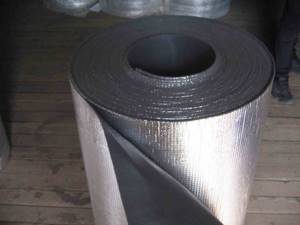
Foil insulation is used for waterproofing, sound insulation and thermal insulation of facades, roofs, walls, floors, ceilings, saunas, baths, partitions, pipelines.
How to make at home
Glue for PVC edges is prepared on your own at home. For this purpose it is necessary:
- Cut pieces of linoleum into small pieces.
- Place them in a glass or metal tightly closed container.
- Add acetone in a volume twice as large as the first ingredient.
- Close the container tightly.
- Place in a dark place for 12-15 hours.
- After dissolving the linoleum, the glue can be used.
The melamine edge or edging with glue on the back side is glued using ordinary tools, for this you need:
- Measure the required length of the melamine edge, taking into account the allowance for trimming.
- Apply the tape, align along one edge and iron, gradually moving 10-20 cm.
- Roll the ironed areas with a roller.
- Rub the heated areas with felt.
- Maintain the heating temperature of the iron.
- After cooling, trim the edges and clean the edges and corners.
You should use a cotton cloth or fluoroplastic iron attachment to maintain the desired temperature. It is more convenient to use a hair dryer instead. If there was a defect during the work, the edge is reheated, removed and all steps are repeated.
If there is no glue on the back side of the tape, proceed as planned:
- Apply Moment glue.
- Distribute over the entire surface.
- Wait 10-15 minutes.
- Press the surfaces to be glued tightly.
- The block is wrapped in felt and pressed tightly against the finish.
- After the glue has dried, begin processing the edges.
Adhesive manufacturers
Superglues are produced by almost all well-known manufacturers of such products, both foreign and domestic. Here are the most popular brands:
- "Contact". Superglue plus primer. The product is sold complete with a primer and is intended for bonding complex and dissimilar materials, including ABS, PP, PE plastics. The primer increases the surface activity of materials, thereby increasing the adhesion of superglue. The main composition is applied to the surface after the primer has completely evaporated.
- "Super Epoxy Moment." This superglue is two-component and does not include cyanoacrylate; instead, it contains epoxy resin. Both components (resin and hardener) are placed in convenient syringes from which they can be squeezed out in strictly measured doses. Superglue "Moment" is ideal for gluing porcelain, crystal, wood, clay products, plastic, metal, and precious stones.
- "Super Grip." Another epoxy two-component superglue, suitable for metals and alloys, glass and ceramics, decorative and facing boards. Can be used for industrial purposes. Superglue does not shrink, is low-toxic, and can be used as a putty or sealant.
- "Monolith". This is one of the cheapest superglues, while still having decent quality. Most often, the composition is used for shoe repair, gluing heels and soles. Superglue will reliably fasten leather, leatherette, vinyl, plastic and metal, wood and all its derivatives.
- "Superglue 505 Universal super strong." The product hardens in 20 seconds, is absolutely transparent, suitable for all materials except Teflon, styrofoam, polypropylene and polyethylene. The disadvantage of superglue is the rigidity of the adhesive seam, which does not withstand fracture loads well. A variety of the product is “Superglue 502”, which is characterized by higher heat resistance.
- "Master". This superglue bonds ceramics, porcelain, plastic, metal, leather, rubber, cardboard and wood. Sold in mini-packs of 3 g, as well as whole blisters containing 12 tubes/3 g.
- "Crocs 301." Universal superglue for any materials, provides reliable bonding for a long time. Seals, fills cracks and chips. It has a very convenient applicator, protected from the composition hardening in the canal.
- "Super Moment Pro." Reliable, long-lasting superglue, packaged in a reusable bottle with a convenient lid. Resistant to moisture, heat-resistant, suitable for all materials except very soft leather, polyethylene, polypropylene, Teflon, silicone rubber. Also, this brand of superglue is not used on glazed surfaces.
- Loctite. A rapidly polymerizing composition based on cyanoacrylate, has a low viscosity. Superglue is intended for any materials, especially those that are difficult to glue. Its stability is less dependent on air humidity than other adhesives. The downside is the high price.
- 5 Second Fix. Other names for glue are plastic welding, liquid plastic fixative. It has an original design in the form of a pen with a thin tip, which is equipped with a battery and an ultraviolet emitter. After applying the product, you need to shine light on it for about 5 seconds, which seriously increases the strength of the adhesive seam.
- Wurth Klebfix. Structural adhesive for installation and repair, easy to open and close, equipped with a spill prevention system. The bottle has a dispenser, and the glue is applied strictly drop by drop. The quality of gluing with this composition is at the highest level.
Backing made of cross-linked polyethylene foam
It is characterized by a different molecular structure, in contrast to its “uncrosslinked” counterpart. The “cross-linking” procedure involves the formation of cross-links of molecular components into a 3D volumetric area with large-format cameras. Cross-linked polyethylene foam substrate is also divided into two groups:
“Cross-linked” polyethylene foam using chemical technology
The method is based on a two-step manufacturing process. The first stage involves mixing polyethylene with cross-linking reagents and foaming agents, resulting in the initial tape (matrix). It is immersed in a furnace unit, where it is subjected to stepwise heating, which causes a chemical reaction.
As a result, the polyethylene molecule, interacting with the cross-linking molecule, acquires altered bonds at the internal molecular level. The last stage is that the resulting blanks again go through the heating stage in the unit, where the final foaming process takes place.
The finished material is yellowish-white or gray in color. Thickness varies from 4 to 15 mm, width - 1.5 m. Sheet material, “cross-linked” by chemical means, has a minimum thickness of 20 mm, and the length and width are 2 and 1 m, respectively. The maximum pore size is 1 mm.
